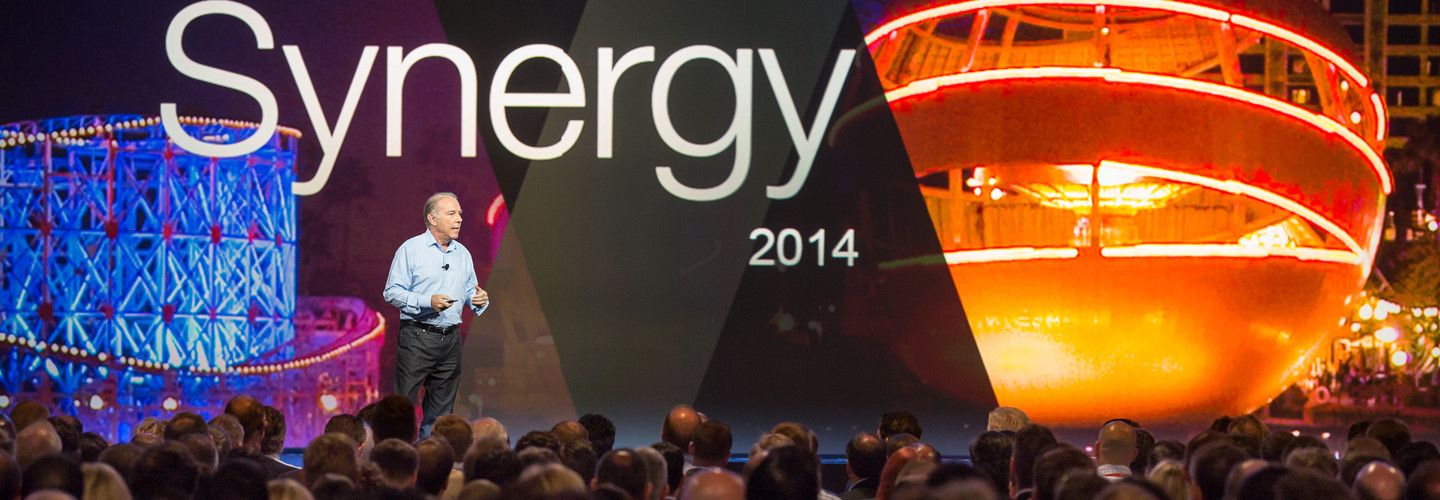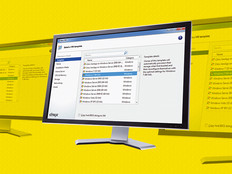Citrix Synergy 2014: Empathy and Mobility Pave the Road to Innovation
Citrix kicked off its annual Synergy conference yesterday with a keynote address by company CEO Mark Templeton, who danced out onto the stage to Pharrell’s hit song “Happy.” Wearing a replica of the singer’s signature Vivienne Westwood hat, the Citrix chief executive set a celebratory tone for the week ahead.
Synergy, he said, is “when you take multiple elements and put them into a system and produce something greater than the sum of their parts.” Not just a marketing pitch to Citrix, Synergy is an ethos for Templeton and his employees.
An early pioneer in the desktop virtualization business, Citrix today is a major player in mobile device management, networking, cloud computing and, of course, all levels of virtualization — from the endpoint to the data center across a variety of software platforms and technologies. To mark Synergy’s seventh year and the company’s 25th anniversary, Templeton announced Citrix’s new Workspace Suite and Workspace Services offerings during his keynote.
Comprehensive Workspaces
The idea behind Workspace Suite is to provide organizations with a soup-to-nuts approach to virtualization that is capable of delivering instant and secure access to all apps, desktops and services from any device over any network. It does so, essentially, by rolling all of the company’s mobile management and collaboration tools and virtual desktop solutions into a single package.
These tools include XenApp, for delivering virtualized apps to the endpoint; XenDesktop, for full Windows-based desktop provisioning and management; XenMobile, for enterprise mobility management; ShareFile, for enterprise-level file sync and sharing; and NetScaler, for optimizing the delivery of Windows-based applications to endpoints (smartphones, tablets, thin clients, notebooks and desktops).
Users can mix and match Workspace Suite components, starting off small and then moving to a full implementation when ready. They can also choose to run Workspace Suite in the cloud on premises, rent space from cloud service providers or take a hybrid approach to deployment.
Rapid DaaS Deployments
Today, Citrix’s Desktop as a Service solutions serve over 350,000 subscribers, through more than 1,500 service providers. Workspace Services is the company’s bid to build on this success by introducing new capabilities for its customers and partners.
It is a cloud-based platform that allows users to rapidly build and deploy customizable virtual desktops by automating the setup, configuration and management of Citrix products.
Although these cloud-based desktops can be built and deployed through any cloud service — including Microsoft Azure, Amazon Web Services and IBM SoftLayer — the control plane for Workspace Services is always in Microsoft Azure. This means that no matter what cloud or clouds users connect to for apps and data, all cloud admin and brokering functions take place in Azure, building on Citrix's longstanding relationship with Microsoft.
“Workspace Services offers choice” not available elsewhere, said Microsoft Corporate Vice President for Cloud and Enterprise Brad Anderson in a video congratulating Citrix and Templeton, whom he recognized as a mentor during the keynote.
Templeton said Workspace Services will enter technical previews during the second half of 2014.
The Real Mobility
Both Workspace Suite and Workspace Services fulfill Citrix’s promise to simplify the deployment and support of Citrix products and services.
As Citrix Senior Vice President of Customer Experience Catherine Courage said during the keynote, “We know users don’t want complex systems, user manuals and training.” Nor do IT workers want to have to support and implement solutions that are a bear to manage and install.
And when Templeton told the crowd, “The ultimate mobile device is us” — meaning people — he wasn’t kidding. “Mobility is actually about the ability to move or be moved,” he said. That is, mobility (or portability) is about the mobility of people, business, apps, data and desktops as a whole.
“We are trying to connect people who have tasks to do with the apps and the data they need,” Templeton said.
For Citrix, the overarching ethos of Synergy really comes down to this concept of mobility driving workforce engagement, which is “the most important factor for any organization — always has been,” he added.
By fully mobilizing workspace productivity and agility, businesses can be ready to respond to any situation, be it an everyday problem or a true emergency.
“There is a new engagement model for IT, about adoption and gaining trust,” Templeton said. Citrix’s purpose is to empower mobile devices and the people that use them to engender that trust.
Built from Empathy
What is the main ingredient Citrix is using to achieve a new workforce engagement model and trust? It’s simple, said Citrix Chief Marketing Officer Steve Daheb.
“Empathy is the key to connecting all the pieces together to best understand how people are working and what they truly need,” said Daheb when he took the stage.
“We are in the age of experience,” he added. “Our workplace is as unique as every one of us.”
Citrix approaches its products as a means of valuing users’ time and helping them get done what matters most to them and their businesses, he said.
Hybrid-cloud provisioning, or the ability to provision any app or desktop workload — be it through a comprehensive solution such as Workforce Suite or an adaptive and extensible cloud platform such as Workforce Services — is how Citrix intends to fulfill its promise of enhancing productivity in the age of mobility.
During the keynote, Citrix Senior Director of Executive Engagement Brad Peterson (also known as the company’s chief demo officer) walked Daheb and Courage through a few examples of how Citrix’s vision is playing out in the real world, demonstrating the Mobile Workspace in a Health IT setting.
With the technology, doctors can access complex patient information and view highly sophisticated images anywhere, on any device — smartphone, tablet, notebook or desktop — in real time.
As for the next 25 years, Templeton said Citrix’s solutions would be driven by five factors: device and network independence, any-to-any security by design, a consumer-like user experience, elastic service capacity and costs and — last but not least — what he called “designful approach to services.” The latter is an attitude to creating products and services that puts as much thought into design as the business problems and tasks they address.








